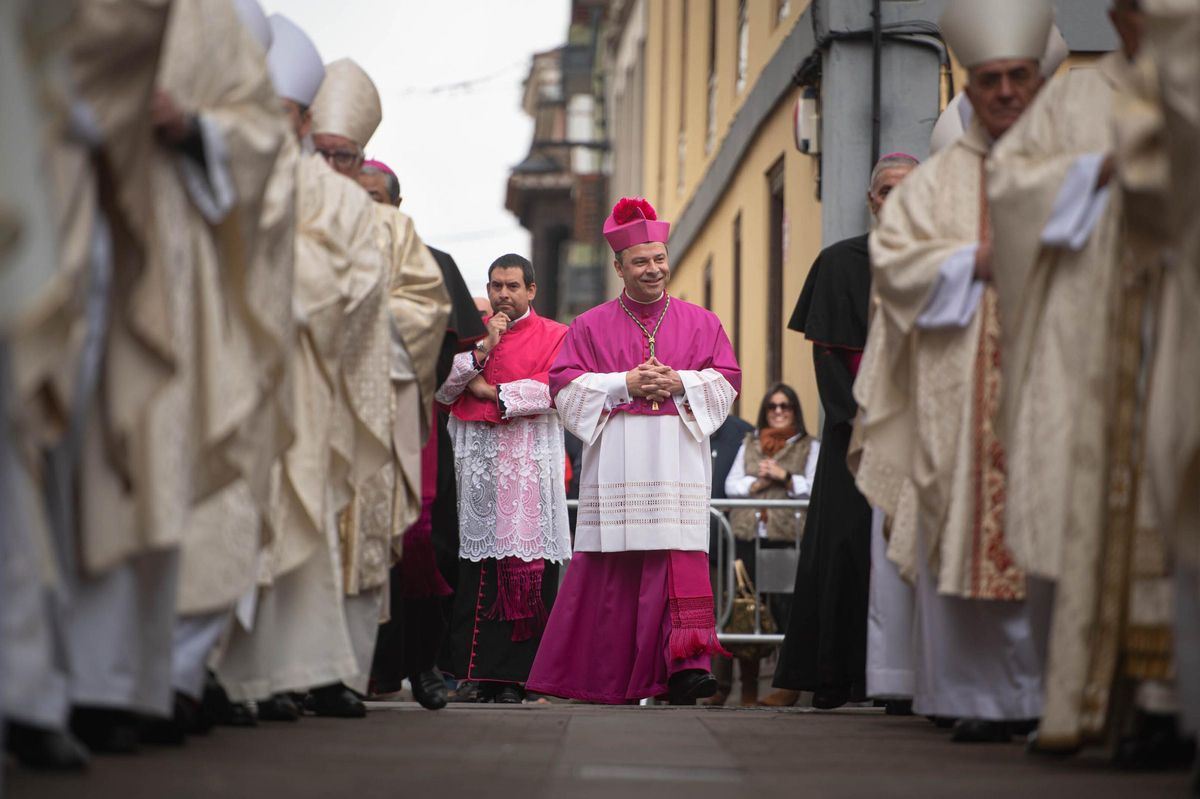Eloy Alberto Santiago is now the bishop of Tenerife. On Thursday, the historic heart of La Laguna, along with its cathedral, became the focal point of an ecclesiastical ceremony that surpassed three hours. The Catholic rite featured around thirty hymns to recognise Santiago’s episcopal appointment and for him to officially take his place as the head of the Nivariense diocese, which encompasses the islands of the province of Santa Cruz de Tenerife. He was joined in the ceremony by approximately 260 priests, various religious figures, and even representatives from other faiths.
Born in 1973 in Las Palmas de Gran Canaria, Eloy Santiago succeeds Bernardo Álvarez as bishop. The new prelate, the thirteenth since the diocese was established in 1819, emerged with a speech laden with spiritual significance, yet balanced with undeniable clarity. “In the Church, there is room for everyone,” he stated. He emphasised the presence of diverse social groups and, notably, expressed his thoughts for the victims of abuse by clergy. “I remember those who have endured violence and abuse within families and institutions, including our Church,” he added.
Atmosphere in the Streets
His remarks followed the conclusion of the ceremony. Yet many events had already unfolded. From the early hours, the five streets of La Laguna were filled with excitement, always reflecting local customs. The occasion gained extra significance amidst the current challenges faced by the Church after the passing of Pope Francis and the upcoming conclave to select his successor.
Just a few minutes before 9:00 a.m., members of Civil Protection began restricting access to certain areas. Residents sought good vantage points while parish communities progressed in groups, alongside authorities, onlookers, and those unsure of the events unfolding. In essence, the characteristic social blend typical of such gatherings was evident. They formed a perimeter outlining what would be the route of the initial procession, complete with 1,800 chairs and several massive screens surrounding the cathedral.
Greetings and Applause
Inside the cathedral, the former Diocesan administrator, Antonio Pérez, moved about, maintaining a calm demeanour. Everything proceeded smoothly. Access was easy, and no crowding occurred. By 10:30, the pivotal moment arrived. At that point, the priests commenced their procession from the bishopric to the cathedral. It was a stretch of 200 metres filled with greetings and applause. The Dean, Juan Pedro Rivero, greeted the soon-to-be prelate at the main entrance, where he sprinkled holy water before proceeding to the altar of Our Lady of Remedies, the patron saint of the diocese, for a brief moment of prayer, and then made his way to the sacristy.

A moment during the procession from the bishopric to the cathedral. / Arturo Jiménez
«Welcome to The Holy Cathedral Church », greeted one of the presenters. The religious hymn PEOPLE OF KINGS provided the musical backdrop as the Bishop entered. “Finally, the day we had been awaiting,” remarked Diocesan administrator Antonio Pérez, expressing a sense of “deep gratitude” towards the Emeritus Prelate, Bernardo Álvarez. “Now is the time to begin writing a new chapter,” he added.
Papal Document
Shortly after, one of the most significant moments of the ceremony occurred, known as the Presentation of the Chosen One. “Do you have the apostolic mandate?” inquired the Nuncio for Spain and Andorra (who will soon assume a role before the European Union), Bernardito Cleopas Auza from the Philippines. “We have it,” replied the Diocesan administrator. “Read it,” urged Auza as he produced the document, signed by Pope Francis, which was then read aloud.
During his homily, the Nuncio reminded Eloy Santiago of the limits of the role he was about to undertake: “It is merely a commission; we do not possess it.” A caution to those involved. The next key moment of the ceremony arrived: the promise of the chosen one. The new prelate was required to respond with “yes, I want” to nine questions and bowed down for an extended period, invoking various saints.
Episcopal Insignia
With the Gospel and the Episcopal insignia (ring, miter and staff) in hand, he proceeded to take his seat. The vacancy in the Tenerife diocese had been filled. Santiago explored the cathedral before returning to the altar, and in his concluding remarks, he requested from God a “wise and discerning heart” to fulfil the responsibilities ahead.
In his message, a style marked by spiritual depth was evident. “The primary role of the bishop” is to “proclaim with fidelity and constancy the gospel of Jesus Christ,” stated Santiago, who also mentioned the “good men and women with an unclear religious sentiment who adhere to certain practices derived from family or the popular traditions of our community, but have not made the leap toward a mature and convinced faith.”
He spoke of the poor, immigrants, those in need, exploited workers, those lacking appropriate housing, the elderly… he expressed gratitude towards the efforts of Bernardo Álvarez and Antonio Pérez, “likely the happiest person at this celebration,” which sparked laughter among the guests. The veneration of the Virgen de los Remedios concluded the event.
















